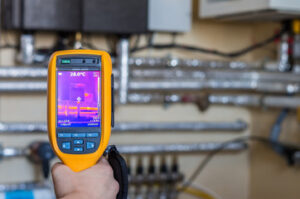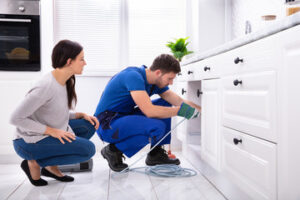A dripping faucet or silent toilet leak may seem harmless, but these leaks can lead to high water bills and structural damage. They can also deplete natural resources and contribute to energy usage and greenhouse gas emissions.

Regular plumbing inspections can help detect leaks early and prevent them from escalating into serious problems. Leak Detection San Diego methods range from basic visual inspections to sophisticated technology that can locate leaks in hard-to-reach areas.
Water leaks are the most common cause of home damage, especially when left undetected. Over time, they can lead to mold growth, structural issues and more. The key is to get the issue addressed early, before it leads to costly repairs and restoration work.
While traditional methods involve breaking through walls or digging up floors to locate the problem, specialized non-invasive leak detection techniques can provide much more accurate results with less disruption to your property. These technologies allow plumbers to pinpoint the source of the leak with remarkable precision.
These innovative technologies include thermal imaging cameras, acoustic leak detectors, and the tracer gas method. Each one has its own unique strengths and advantages, but all offer minimal disruption to your property while providing highly reliable results.
For example, acoustic leak detection is a non-invasive way to identify the location of leaking water. It uses specialised equipment that listens to the sounds of water escaping pipes, amplifying them so plumbers can hear them better. The process eliminates the need for extensive destruction of your property, saving you money and preserving your home’s aesthetic.
Another popular non-invasive leak detection method is the use of pressure testing technology. This technique can be used to test for leaks in plumbing systems, gas pipelines and other pressurised systems. However, it requires the system to be isolated and under pressure, which isn’t always possible or practical.
Other non-invasive leak detection techniques include distributed fibre optic sensing and ground penetrating radar (GPR). These methods can be used to detect buried pipes without requiring access to the site. They can also monitor the condition of underground pipes and identify areas where leaks are likely to occur.
Whether you’re looking for a professional to help you with leak detection or need assistance in repairing a leaking pipe, the team at Jetset Plumbing is on hand to help. Contact us today to discuss your options or arrange an appointment. We can assist with a range of plumbing issues, from faulty taps to burst pipes and everything in between. We pride ourselves on offering a fast, efficient service with excellent customer support.
Detection Methods
There are a variety of leak detection methods that can be used to locate water leaks in residential and commercial properties. Many of these tools are highly effective and non-invasive. These devices can help reduce the amount of money spent on water bills and prevent damage to the structure of a building.
Water leaking from a pipe will create sound waves that can be detected with specialized equipment. Sound-based leak detection devices are especially useful for locating water leaks in pressurized pipes. They work by allowing your plumber to hear the sound of escaping water, which helps pinpoint the source of the leak. This method of leak detection is also effective for identifying hidden leaks in walls and floors.
Some of the more advanced leak detection technologies use infrared scanning or ultrasound to identify a leak in a pipe system. This type of technology is typically more expensive than traditional techniques, but it can provide more accurate results. Ultrasound testing can detect a leak with incredible accuracy, especially in hard-to-reach areas or on underground pipes.
One of the most common leak detection methods involves observing water and gas meter readings over time. If the meter readings continue to increase, you may have a leak in your plumbing. Other leak detection methods include a video inspection of your plumbing, which uses a camera to scan for signs of water leaks or pipe damage. A water meter survey is another option that can be performed by your plumber using a device that measures the changes in pressure caused by a leak.
There is no single leak detection technique that works best for all sites. Leak rate, groundwater depth, soil conditions and piping configuration are just some of the factors that influence which leak detection technique is appropriate for your facility. Regulatory authorities have specific requirements that must be met when choosing a leak detection method, including the minimum “probabilities” for detecting certain leak rates and the number of false alarms that can occur. Your UST service provider can recommend the most suitable leak detection method for your site based on these considerations.
Detection Devices
Detecting leaks quickly is critical for saving money, protecting property, and conserving water. The longer a leak goes undetected, the more costly it becomes to address and the greater the potential for structural damage and water wastage. Leak detection devices provide early warnings that can allow repairs to be made before the issue escalates, reducing costs and minimising damage.
Smart leak detectors use sensors to monitor for the presence of liquid. They are often installed close to the point where water enters a home, such as under sinks or in basements. Some devices, like Flo and Flume, can be controlled remotely and shut off the water supply automatically in response to a detected leak, while others, such as First Alert’s WiFi Water Leak and Freeze Detector, send alerts via smartphone or computer app, allowing homeowners to act quickly.
Most systems work by monitoring the rate at which water flows through the pipes over a set time. If the flow is abnormal, it can indicate a leak or that there has been an increase in water usage. This type of system is easy to install, and can be used in conjunction with a traditional shut-off valve for added protection.
Other systems, like a water meter with flow interrupter technology, actually shut off the water supply when they sense an abnormal amount of water flowing in and out of the meter. This type of system is normally installed by a professional, and it can save on water bills by shutting off the supply when it’s not needed.
A third option is a sensor that uses ultrasonic waves to locate the source of the leak, with most systems offering an audible or visual indicator and a smartphone app to view results. This type of system is typically installed by a professional and may be more expensive than other methods, but it can be very effective at finding leaks in hard-to-reach areas.
Choosing the right leak detection system for your needs depends on a number of factors, including cost and level of expertise required to operate and interpret results. Professional-grade devices can offer more advanced features and higher accuracy, but may require specialised training to understand and apply correctly. DIY options are more user-friendly and affordable, but they may not be as accurate for detecting specific locations of moisture or leaks.
Repair Options
When plumbing leaks are left unattended, they can result in severe damage and costly repairs. The best way to avoid this is by scheduling professional leak detection at the first signs of a problem. These services will identify the source of a leak, which is often situated behind walls or underground, and then develop a plan to repair it.
The first step is to shut off your water supply in order to prevent further damage and ensure that the plumber can access the leaking area. The plumber will then begin to find the source of the leak, which may involve a visual inspection or using electronic leak detection equipment. If the leak is buried underneath the surface, a trenchless survey can be performed to locate it without digging or disturbing your property. Once the plumber has located the leak, they can then surgically expose the affected pipe section and initiate the leak repair process.
Depending on the location of the leak and the condition of the pipes, there are a number of different repair options available. A direct repair involves cutting through the concrete slab to access and repair the damaged section of pipe. This is a fairly invasive procedure, but it can be necessary for severe leaks. Another option is to reroute the water around the damaged section of pipe. This can be a less invasive option, but it may not be suitable for severe leaks or older pipes. Finally, it is possible to fix a slab leak with epoxy pipe coating. This is a non-invasive method that can be used to fix both copper and PEX pipes.
The cost of repairing a leak can vary significantly, depending on the type and severity of the leak, and the state of the pipes. However, the cost of ignoring a leak can be far greater, as it can cause expensive damage to your home and foundation. In addition, it can also lead to health issues and increase your water bill dramatically. Regular plumbing inspections and proper maintenance can reduce the risk of leaks and other problems.
